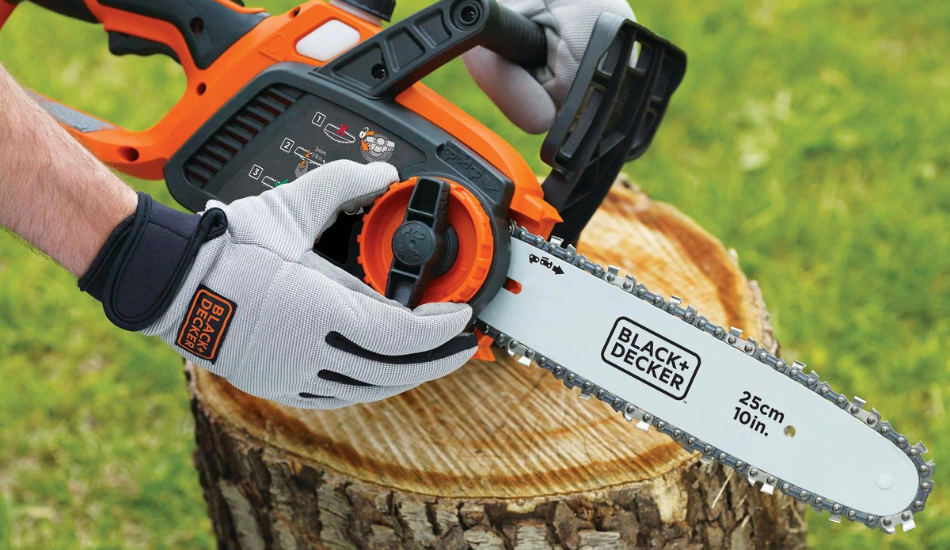Keeping your chainsaw sharp is crucial for effective cutting and safety. If you’ve noticed your chainsaw isn’t cutting as smoothly as it used to, learning how to sharpen a chainsaw with a file can make a big difference. A well-sharpened chainsaw will not only cut more efficiently but also be safer to use.
Content Breakdown
ToggleIn this guide, we’ll walk you through the simple tips on How to sharpen a chainsaw with a file. From gathering the right tools to applying the correct techniques, we’ll cover everything you need to know to get your chainsaw back in top shape. By following these straightforward instructions, you’ll be able to maintain a sharp edge and enjoy smoother, more precise cuts.
Ready to get started? Let’s dive into the step-by-step process of How to sharpen a chainsaw with a file and make sure your chainsaw is always ready for action.
What You’ll Need
Chainsaw File: A round file specifically designed for chainsaws. This is essential for sharpening the teeth of the chain.
File Guide: A tool that helps maintain the correct angle while filing. It ensures that each tooth is sharpened consistently.
Depth Gauge Tool: This tool measures the height of the depth gauges, or rakers, to ensure they are properly set. Adjusting these helps the chainsaw cut efficiently.
Safety Gloves: Protect your hands from sharp edges and debris while working. Safety gloves are a must to avoid injuries.
Preparing Your Chainsaw

Safety First
Before you start sharpening your chainsaw, make sure it’s turned off and completely disconnected from any power source. Secure the chainsaw on a stable surface to prevent it from moving while you work. Engaging the chain brake is also a good practice to ensure safety.
Clean the Chainsaw
Remove any debris or dirt from the chainsaw, especially from the chain and bar area. Cleaning the chainsaw ensures that no particles interfere with the sharpening process and allows you to work more effectively. Use a brush or compressed air to clear away sawdust and other residues.
How to Sharpen a Chainsaw with a File
Here are 7 easy steps and tips on How to sharpen a chainsaw with a file.

Step 1: Secure the Chainsaw
Start by placing your chainsaw on a flat, stable surface. Ensure it’s completely turned off and the chain brake is engaged. Use a bench vise or chainsaw holder to keep it steady, giving you better control as you learn how to sharpen a chainsaw with a file efficiently.
Step 2: Identify the Sharpening Angle
Chainsaw teeth cut at a specific angle, usually between 25 to 35 degrees. If you’re unsure of the exact angle, refer to your chainsaw manual. For most models, a 30-degree angle works well, providing a balance between cutting efficiency and durability.
Step 3: Position the File Guide
Attach a file guide to the chainsaw’s bar. The file guide helps maintain the correct angle and ensures uniform sharpening of each tooth. Align the guide with the chain’s teeth, making sure it’s positioned correctly according to the angle specified in your chainsaw’s manual. The guide will typically have markings to help you set the correct angle. Secure it firmly to prevent any movement during filing.
Step 4: File the Teeth
Starting with the first tooth, place the file into the cutting edge of the tooth. Apply firm, even pressure as you move the file from the base of the tooth to the tip. Use a smooth, steady stroke to file the tooth. File each tooth in the direction of the chain’s rotation to maintain the correct cutting edge. It’s important to use consistent strokes to ensure that all teeth are sharpened evenly.
Step 5: Check the Depth Gauge
After sharpening the teeth, check the depth gauges, also known as rakers. These are the small protrusions in front of each tooth that control the depth of the cut. Use a depth gauge tool to measure their height. The depth gauges should be lower than the cutting teeth. If they are too high, file them down to match the recommended height. This adjustment ensures optimal cutting performance and safety.
Step 6: Repeat on All Teeth
Continue the sharpening process for all the teeth on the chain. It’s essential to maintain consistency in angle and pressure to ensure that every tooth is sharpened equally. Rotate the chainsaw if necessary to access all the teeth comfortably. Take your time with each tooth to ensure thorough sharpening. It’s often helpful to count the number of strokes you use on each tooth to maintain consistency.
Step 7: Final Checks
Once all the teeth have been sharpened, inspect the chain to ensure all teeth are evenly sharpened and free of any damage. Run your fingers gently along the chain to feel for any inconsistencies. Check the tension of the chain and adjust if necessary. Reattach any parts you may have removed and clean up any filing debris. Finally, test the chainsaw on a piece of wood to ensure it cuts smoothly and effectively.
Also Read: 7 Essential Chainsaw Tips for Beginners in 2024
Best Chainsaw Sharpening Techniques
You want to learn how to sharpen a chainsaw with a file? Here are some sharpening techniques that will help you when sharpening your chainsaw.

Technique Tips
Use Consistent Pressure
Apply steady, even pressure when filing each tooth. Avoid pressing too hard, as this can damage the tooth or cause uneven sharpening. Let the file do the work and maintain a consistent stroke for best results.
File in One Direction
Always file in the direction of the chain’s rotation. This technique helps maintain a sharp and precise edge on the cutting teeth. Avoid back-and-forth filing, which can dull the blade.
Check for Uniform Sharpness
Regularly check each tooth to ensure they are sharpened uniformly. Uneven sharpening can lead to poor cutting performance and increased wear on the chain.
Keep the File Clean
Ensure your file is clean and free from debris. A clogged file can reduce its effectiveness and lead to uneven sharpening. Use a wire brush or file cleaner to keep it in good condition.
Adjust Depth Gauges
After sharpening the teeth, make sure the depth gauges (rakers) are correctly adjusted. They should be lower than the cutting teeth to allow for efficient cutting. Use a depth gauge tool for precise adjustment.
Angle for Sharpening
The angle at which you sharpen the chainsaw teeth is crucial for optimal cutting performance. Generally, the recommended sharpening angle is between 25 to 35 degrees.
- 25 to 30 Degrees: This angle is suitable for most chainsaws and provides a balance between cutting efficiency and durability.
- 30 to 35 Degrees: This angle can be used for more aggressive cutting and is ideal for harder or thicker materials.
Read your chainsaw’s manual for the exact recommended angle for your specific model. Maintaining the correct angle ensures that the chain cuts efficiently and reduces the risk of damage or poor performance.
How Long Does a Chainsaw File Last?

When you’re learning how to sharpen a chainsaw with a file, it’s important to know how long your file will last. A chainsaw file can last anywhere from several months to a few years, depending on how often you use it and how well you take care of it. If you’re using it frequently or on tough materials, it might wear out faster.
When Should You Replace Your Chain
Dulled teeth
If you’re noticing that sharpening your chain with a file takes more strokes than usual or isn’t restoring the sharpness effectively, it might be time to replace the file. Knowing how to sharpen a chainsaw with a file is essential, but even the best technique won’t help if the file is worn out.
Visible wear
Check your file for visible signs of damage, such as chipped or worn teeth. If you spot these issues, it’s likely the file is no longer effective, and replacing it is the best option.
Ineffective sharpening.
If you’re following the proper steps for how to sharpen a chainsaw with a file but still can’t achieve a sharp edge, the file itself could be the culprit. When the file isn’t performing as it should, it’s time to get a new one to keep your chainsaw working efficiently.
Tips to Make Your Chainsaw File Last Longer
Keep It Clean
Regularly clean your file to remove debris and resin buildup. This not only ensures better performance but also extends the file’s life. Avoid harsh chemicals; instead, use a soft cloth or brush and mild soap. Rinse and dry thoroughly before use.
Store It Properly
Always store your files in a dry, safe place to prevent rust or damage. Using a protective case helps avoid exposure to moisture and direct sunlight, both of which can deteriorate the file over time.
Use It Correctly
Make sure you’re using the correct size and type of file for your specific chainsaw chain. Following the manufacturer’s instructions and applying even pressure will lead to a sharper chain. Knowing how to sharpen a chainsaw with a file correctly ensures better performance and a longer file life.
Inspect Regularly
Before and after each use, inspect your file for signs of wear or damage. Catching problems early can help you maintain a sharp and effective chainsaw, ensuring smoother cuts and less wear on your equipment.
Also Read: The 10 Best Chainsaw for Cutting Trees: Your Ultimate Guide
Common Mistakes to Avoid When Sharpening a Chainsaw with a File

When learning how to sharpen a chainsaw with a file, avoiding common mistakes can significantly improve your results and make the task safer. Here are some pitfalls to watch out for:
Neglecting Proper Preparation
One of the biggest mistakes when sharpening a chainsaw with a file is not securing the chainsaw properly. If the chainsaw isn’t stable, you risk injury and will struggle to sharpen the chain evenly. To prevent this, always ensure the chainsaw is turned off and secured in a vice or on a stable surface before starting.
Using Incorrect Angles
Another frequent error is sharpening the teeth at the wrong angle. The correct sharpening angle is crucial for effective cutting. If you use the wrong angle, you might damage the chain or make it less effective. To avoid this, check your chainsaw’s manual for the recommended angle, typically around 30 to 35 degrees, and use a file guide to maintain this angle consistently.
Applying Uneven Pressure
Applying inconsistent pressure while filing can lead to uneven sharpening. This can result in poor cutting performance and quicker wear on the chain. For the best results, apply steady, even pressure throughout each stroke of the file to ensure a uniform sharp edge.
Ignoring the Depth Gauge
Forgetting to check the depth gauge is a common mistake that can affect the efficiency of your chainsaw. The depth gauge ensures that the cutter teeth are at the proper height. Use a depth gauge tool to check and adjust the height of the teeth after sharpening to maintain optimal performance.
Over-Filing the Teeth
Over-filing is a mistake that can weaken the teeth of your chainsaw chain and reduce its lifespan. It’s important to file just enough to restore sharpness without removing too much material. Regularly check the teeth’s condition to avoid excessive filing.
Not Cleaning the File
Finally, not cleaning the file regularly can diminish its effectiveness and lifespan. Debris and resin buildup can obstruct the file’s performance. Clean your file with a wire brush or file cleaner after each use to keep it in good condition and maintain its sharpness.
By being mindful of these common mistakes when learning How to sharpen a chainsaw with a file, you can enhance your sharpening skills and ensure your chainsaw performs at its best.
Best Chainsaw Sharpener Files to Buy
If you’re looking for high-quality files and sharpening tools to get the job done, here are some recommended options:
- Oregon Universal Chainsaw Field 7pc Sharpening Kit: A comprehensive kit that includes all the essential tools for sharpening your chainsaw.
- Husqvarna X-Cut SP33G Chainsaw File Kit: A reliable kit designed specifically for Husqvarna chainsaws but versatile enough for other brands.
- Oregon 5/32-Inch (4.0 mm) Professional Chainsaw Chain Sharpening Round Files: Precision files ideal for maintaining the sharpness of your chainsaw chain.
- PFERD 17304 Chain Saw Sharpener CS-X, File 7/32 inch: Known for its durability and efficiency in sharpening chainsaw teeth.
- Oregon 25894 5/32-Inch Chainsaw File Guide with File: Includes a guide to ensure accurate filing angles and even sharpening.
These tools will help you maintain your chainsaw’s performance and ensure it remains a reliable tool for all your cutting needs.
FAQs
Here are some common FAQs on How to sharpen a chainsaw with a file.
To sharpen your chainsaw with a file, start by securing the chainsaw and setting the right sharpening angle. Use a file guide to keep things steady, file each tooth evenly, and check the depth gauge regularly. Make sure to follow safety steps and consult your chainsaw’s manual for specifics.
Absolutely! Sharpening a saw with a file is a straightforward and effective way to keep it in top shape. Just use the right file size and follow the correct technique for the best results.
Sharpening your chainsaw teeth involves securing your chainsaw, finding the right sharpening angle, and using a file guide. File each tooth carefully and check the depth gauge to ensure they’re all sharp and ready for action.
For the best sharpening results, use the correct file and maintain the right angle. Apply even pressure while filing and regularly check the depth gauge. Consistency and proper maintenance will keep your chainsaw cutting smoothly.
A chainsaw file can last through several sharpening sessions if you take good care of it. Watch for signs like reduced efficiency or visible wear to know when it’s time for a replacement. Regular cleaning and proper maintenance can help extend its life.
Typically, you’ll sharpen a chainsaw at an angle between 25 and 35 degrees. This can vary, so it’s a good idea to check your chainsaw’s manual for the exact angle to ensure the best performance.
Video Guides On how to sharpen a chainsaw with a file
If you prefer a detailed video instead of article on How to sharpen a chainsaw with a file, you can follow the video below.
Conclusion
Our final thoughts on how to sharpen a chainsaw with a file. Sharpening your chainsaw with a file is a straightforward yet essential task to keep your tool in top condition. By following the steps outlined in this guide, you can effectively sharpen your chainsaw and enhance its cutting performance. Remember, the key to a well-maintained chainsaw lies in regular sharpening and proper technique.
If you need more guidance, check out video tutorials and consider investing in quality sharpening tools. Proper maintenance will extend your chainsaw’s lifespan and ensure safer and more efficient operation. Ready to get started? With these tips on how to sharpen a chainsaw with a file, you’ll be well on your way to mastering chainsaw maintenance!








